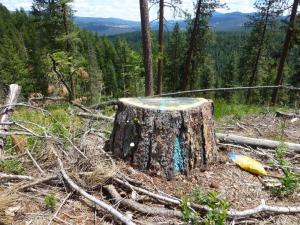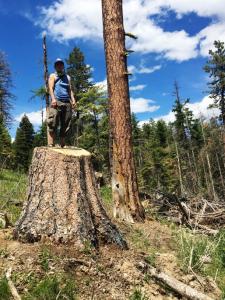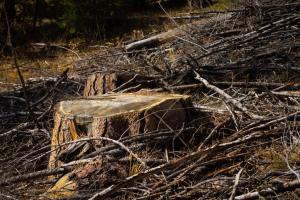Not long ago, we asked our members and supporters to speak up for Eastern Oregon’s old-growth forests. As expected, Trump's Forest Service didn’t listen. Now the Biden administration is defending a grievous mistake.
Worse yet, in a recent email many of our members received, the Forest Service claimed they had strengthened protections. It’s simply not true, and we want to set the record straight.
Since Bill Clinton was president in the 1990’s, a series of rules known as the Eastside Screens, ensured that the largest 3% of Eastern Oregon’s trees were generally off limits to commercial logging on public lands. As the Trump era began to wane, political allies of the timber industry went all in to undermine long standing environmental safeguards like the Screens.
 With the world in disarray, under intense political pressure, and with token support from unapologetic collaborators, the Forest Service began a process to undo The Screens. Despite opposition from independent scientists, public interest organizations, former agency leadership, and thousands of citizens, just hours before Joe Biden was inaugurated, a Trump appointee signed a decision abruptly concluding the already rushed, political, and predetermined process to put into place what are now widely known as The Trump Screens.
With the world in disarray, under intense political pressure, and with token support from unapologetic collaborators, the Forest Service began a process to undo The Screens. Despite opposition from independent scientists, public interest organizations, former agency leadership, and thousands of citizens, just hours before Joe Biden was inaugurated, a Trump appointee signed a decision abruptly concluding the already rushed, political, and predetermined process to put into place what are now widely known as The Trump Screens.
A distracted Biden administration has focused on other priorities and ignored its own guidance. While Oregon’s senators stepped up for West side forests, they remain officially neutral on a rule change affecting millions of acres of public lands here in Eastern Oregon.
In a Trumpian move, Biden’s Forest Service recently sent an email to folks they ignored in the development of the process that was full of half truths, omissions, and misleading information about the Trump Screens. Many asked us about it, and we want to set the record straight. These are just a few of the problems:
- The Trump Screens eliminated mandatory protections for many large trees up to 30” in diameter and under 150 years old.
- The Forest Service can log large and old trees where they are locally abundant.
- While the Forest Service is telling you small old trees gained protection, the guidelines are nearly impossible to implement accurately. Violations will only be noted if tree rings are counted on stumps, and everyone knows you can’t put trees back on stumps. There are no enforceable mechanisms for accountability.
- The Forest Service weakened protections for large trees by shifting from enforceable standards to guidelines that they (and industry) hope they can follow or ignore at their whim.
 The Forest Service is asking for your trust. This summer, I have seen numerous examples of what that means.
The Forest Service is asking for your trust. This summer, I have seen numerous examples of what that means.
- In the Malheur National Forest, I counted tree rings on old-growth Ponderosa Pine stumps in a “collaborative restoration” project touted as an example of why the Trump Screens would be beneficial.
- I watched trees over 200 years old being cut in the Lostine River Canyon.
- I went on a field trip in the Hells Canyon National Recreation Area where towering old Doug Fir were marked for logging and native forests were slated for clearcuts because even the Forest Service doesn’t understand its new rules.
- Not far away, on the Imnaha River, I looked at Ponderosa Pine stumps that had begun growing hundreds of years before Oregon became a state.
All the photos here are from those projects. And the Trump Screens haven’t even been implemented yet...
We’ll continue to be your eyes and ears in the forest. When the chainsaws come out - as they will - we’ll take action, let you know, and ask for your support again.
In the meantime, if you want to remind your Senators that this is a big deal and you haven’t forgotten, you can call Senator Merkley at 503.326.3386 and Senator Wyden at 202.224.5244.
Ask them to oppose the Trump amendment to the Eastside Screens and help protect large and old trees in Eastern Oregon’s National Forests.

Thank you to Blue Mountain Biodiversity Project, Greater Hells Canyon Council, Central Oregon LandWatch, WildEarth Guardians, the Great Old Broads for Wilderness, and the dozens of organizations who are fighting this effort to restart logging big and old trees in Eastern Oregon! Thank you also to volunteer photographer Daniel Howland for his help documenting the values at risk.
Stump With Paint and Stump With Person by Paula Hood, Blue Mountain Biodiversity Project (Big Mosquito Logging Project, Malheur National Forest)
Stump In Slash by Daniel Howland (Big Mosquito Logging Project, Malheur National Forest)

